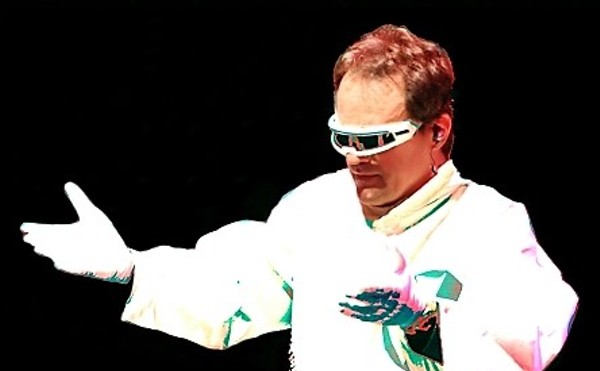The Story of the Ghost
(Elektra)
When you have that "jam band" tag like Phish does, it's equal parts blessing and curse. Staggering concert numbers prove that, when Phish hit the road, there'll be a looong trail of vehicles following. When your live show is not only your strength but your natural environment, having as many of those inspirational moments captured--whether by CDs or bootlegs--seems like the ideal way to spread the group's growing legacy. Even Phish's official live albums, A Live One and Slip Stitch and Pass, have been the best commercial way to encounter the talented foursome's abilities.
The problem then for Phish is what to do with your studio albums--the body of work that expands and truly blooms on the stage. Try to free-form jam nine-minute opuses in a studio, and you might as well set an alarm clock at the end to keep the engineer with you. It's all in the spontaneity and crowd interaction--not piecing together takes six, seven, and eight.
Faced with this issue once again, Phish has decided to take a somewhat new approach on its latest effort, letting the tape roll through a few extended studio jam sessions and finding the best bits and pieces to form the foundations of numerous songs--first takes, fresh and untainted. The bizarre thing: The Story of the Ghost is further from a jam-laden album than the band has been. Most tunes wrap up with the brevity of a traditional pop song, and while Phish doesn't necessarily follow all the traditional pop album formulas, a traditional pop album is what it's ended up with. And a very good one.
The more up front they are, the bigger the highlight. The fat organ sounds (always a good choice for the flowers-in-the-head twirling dances) pumping through the swift "Birds of a Feather" let Phish unveil its improvisational skills with cool, springing finesse instead of raw, monotonous power. Elsewhere, "Water in the Sky" gallops along with a Western swing and ragtime piano that leads the lighthearted, infectious fun. These are two prime examples of Phish's proficiency with writing--dare it be mentioned--hit songs.
Midway through the album, after a few experimental, sparse, low-key arrangements that could pass as outtakes by Willy Wonka's Oompa Loompas, Ghost really settles in. "Limb By Limb" is the only track that puts a soaring lead guitar solo into the mix, as the band usually unites as one instead of featuring single members. From there, "Frankie Says" and "Brian and Robert" provide harmony-rich, soothing grooves. The dreamy tones and typically ponderous lyrics fall perfectly into place here.
For all the band's newfound studio-friendly sound and production perfection, mistakes can be found, leaving Ghost slightly unbalanced. The one song that the guys brought into the studio from the road is "Guyute." With its tiresome plodding and Rush-like flexing of instrumental chops, it should have never surfaced here, especially on an album that tries so hard to steer clear of such noodling. Continuing down that tedious path, "The Moma Dance" manages to funk its way into annoyance shortly after it begins. Similarly, thick bass lines are bounced around on the album-opening "Ghost," but it's done more subtly and tastefully. Thankfully, Phish doesn't overindulge in the funk-for-funk's-sake mentality on this album, instead wisely concentrating on numerous other musical styles, as well.
A new era for Phish seems to have been unleashed with The Story of the Ghost, which is exactly what the band needed to do to reach the masses--not that that was ever Phish's goal. If they continue to grow and challenge themselves in the studio as they did here, their legacy may not be relegated to haunting the miles and miles of roads they're fabled for traveling.
--Kelly Benjamin
Reel Big Fish
Why Do They Rock So Hard?
(Mojo)
After achieving success two years ago with their debut album Turn the Radio Off, Reel Big Fish is back again with another batch of pop-oriented, radio-friendly ska songs. Why Do They Rock So Hard? is pretty much in the same vein as its predecessor, with only slight differences in production.
This time around, Reel Big Fish makes no bones about its bread-and-butter sound. The band has put its brassy horns and metal-influenced guitar riffs way out front. The multilayered kiss-off track "You Don't Know," aimed squarely at the media, allows the band to hit all of its strengths in compact fashion: a wall of horns, solid island rhythms, and antiestablishment lyrics. Where Reel Big Fish truly shines is with the interplay between the brass section and the three-chord guitar riffs. Mingling about, yet with a purpose, they both create momentum, while Aaron Barrett's hubristic vocals fill in the missing pieces: Well first I'd like to say fuck off/If you don't get it why don't you go shove your head back up your ass/And don't waste my time/I don't need your opinion. And the rest of the album follows suit.
"The Set Up (You Need This)" is basically the same mixture of instruments, with the early '80s power-chord-heavy guitar taking the lead. The supporting cast includes the omnipresent horns and punk-based melodies. The band does get greedy on "Big Star." Using a cheesy, uncharacteristic acoustic guitar and gentle vocals, the Fish momentarily digress from their in-your-face sound. Just as you might give up on the throwaway track, a ripping guitar emerges, returning the band to its original style. While its latter half is powerful, the innocuous beginning does nothing for the listener.
Reel Big Fish knows it's riding a trendy wave of popularity that will eventually crest. "Down in Flames" is the band's answer. With its tried-and-true ska-punk sound, the abrasive tune's lyrics say it all: We had our chance/Made our point/But you're not going to take that/When this blows over and the mainstream coughs up another shell/Will you let us back in your underground/Well I guess that's a no.
What's interesting about Why Do They Rock So Hard? is the album's sense of urgency, as in "Listen now, because in the not-so-distant future the ska/pop/punk scene will once again go back into hibernation."
--John Benson
PJ Harvey
Is This Desire?
(Island)
Nothing is happening for the first five seconds of Polly Jean Harvey's new album. It is in those five seconds of nothingness that the magic of Harvey is revealed. The swelling and heightening of the senses in moments of anticipation are the things Harvey's songs are made of. The racing of a lover's heart right before a kiss; the sinking of that heart when it's about to be torn out. Eyes bulging and ears perking during a solitary walk in the dark of night. The climaxing moment has yet to take place, but the body is prepared for an ensuing explosion.
On Is This Desire? Harvey, the Great Anticipator, goes about deconstructing those raw nerves in numerous ways. She strikes subtlety with the hollow and stark "Catherine," her low, seductive, soulful vocals accompanied by a muted bass and keyboard melody lightly swishing along the surface. On the other end, she blasts through with a slobbering, buzzing wave of sound that oozes all over on songs like "My Beautiful Leah," on which she disturbingly reads/sings her lyrics in a tone that warns of the oncoming disaster.
Throughout the album, Harvey and her numerous crucial collaborators masterfully manipulate sounds and textures to keep the album contorting along with the potent, edgy lyrics. As Harvey whispers about a lonely, isolated woman on "The Wind," a sparse hip-hop beat surfaces as she repeats the whispered words with floating vocals and a chilling string accompaniment. A sawing, industrial beat is the backdrop on "Joy," as Harvey cries her words of distress--No hope for joy/No hope for faith/She wanted to go blind/Wanted hope to stay.
Every song has Harvey singing in a different tone or style, in the same way the music is in constant flux, yet Is This Desire? stands coherently and boldly as a unit--a true credit to Harvey's vision, one that is vast and daring, yet not splattered irresponsibly.
Harvey's sonic rock explosions, which garnered her much ado earlier in her career, are limited to only a few tracks. A traditional semblance of a band--drum, bass, and guitar--is really only found on "The Sky Lit Up," while the album's most aggressive track, "No Girl So Sweet," bounces around a driving, techno beat and distorted, wailing vocals. Her only foray into a bluesy din is "A Perfect Day Elise," which has a slight, Jon Spencer-nasty groove to it.
Noisy fireworks aren't needed, though, as Harvey lets her truly cunning vocals expand on the jazz shuffle of the opener "Angelene" and the elegantly fragile title track that closes the album.
Harvey is the artist's artist--a provoking, challenging, uncompromising soul who continues to put out albums on the edge. Usually, that would garner an avant-garde tag, and while Harvey may be considered such by the masses, she'll eventually get her due on the merit that she's one of the few artists who constantly delivers with stunning quality.
--Benjamin
Neil Diamond
The Movie Album: As Time Goes By
(Columbia)
Of all the folks in the music business who can get away with doing what they want, how they want, with whom they want, and when they want, few can pull it off as well and often as Neil Diamond. It's a perk that he's earned over the years, and as long as the caliber of his output remains great, he should be able to keep it.
Recent outings have found Diamond dabbling in country music and Christmas themes. This time around, he's turned to cinema for inspiration. The 21-song disc features more movie themes than stereotypical show-tunes, so don't expect to find "Oklahoma!" "Age of Aquarius," or "I Could Have Danced All Night" here. The material roughly spans the last half-century, with Casablanca's "As Time Goes By" representing the early years, and The Lion King's "Can You Feel the Love Tonight" and Titanic's "My Heart Will Go On" nodding to the Nineties.
The arrangements have all been tailored to Diamond's schmaltzy style and are performed by an eighty-piece orchestra, conducted by revered film composer/conductor Elmer Bernstein. Much of what is offered here is really gorgeous; Diamond can boost the romance level on nearly any song he touches, in some way making it his own. A wonderful example is his treatment of "Secret Love," made famous by Doris Day in Calamity Jane. Day's version had a fanciful air to it; in the hands of Diamond, it comes across with a more tangible feeling of romance. The same holds true for the Righteous Brothers' "Unchained Melody" (from Ghost) and "When You Wish Upon a Star" (Pinocchio). Granted, it's not hard to outsing a cartoon cricket.
Also noteworthy are his versions of David & Bacharach's "The Look of Love" from Casino Royale, Elvis's Blue Hawaii hit "Can't Help Falling in Love," the Beatles' "And I Love Her" (A Hard Day's Night), and a Frank Sinatra medley.
Even with the custom-built arrangements for Diamond, not all of them fit the pieces. He may have been better off not to mess with the tempo of "Puttin' on the Ritz" or the complicated "Windmills of Your Mind." And sorry, Neil, Henry Mancini's "Moon River" will never sound better than it did coming out of the mouth of Audrey Hepburn in Breakfast at Tiffany's.
--Lee Barrish
Ace and the Ragers
Light This Sucker Up
A few years and several local releases back, the fact that a band played swing, rockabilly, or some strange cabaret combination of the two was enough to set it apart from the crowd, and not much in-depth analysis was needed. They were . . . well, different.
Now that the Voodoo Daddies and Nutty Squirrel Zippers are dropping out of the trees, some serious discussion as to what is good and bad within the genre is in order. And in short, Ace and the Ragers, judging from their new release, are a few notches above incredible. From the lyrical bombast of "Let's Move" to the genuinely youthful, innocent rendering "Christine," the Ragers seem oblivious to the idea that there's even a retro resurgence going on.
With omnipresent sax, unrelenting rhythms, and lyrics like When I get you alone, don't know what I'm gonna do/I'm gonna kiss your little lips until I turn 'em black and blue ("Little Lizzy") and She don't care for parties/She don't go to shows/She don't care if it's forty below/She wants to take off all of her clothes ("Boom Shanga-Langa"), the impression is that these guys came out of the womb doing this stuff.
More than having the rockabilly groove down cold vocally, musically, and in pure attitude, they manage to bring all the humor, fury, and romance that the music demands without stooping in the least to histrionics or novelty.
Simply put, either Ace and the Ragers are the best actors in Northeast Ohio or, even more frighteningly, they're the most authentic roots-rock band to surface in years. Which shouldn't serve to impress many progressive-minded musicologists, but for those who dig a dirty sax, tribal percussion, clean tremoloed guitar leads, and crazed, unrepentant tunage with a dash of clever seasoning, Light This Sucker Up is a four-course delight that's tough to beat. Somebody pass the Tabasco.
--Brian Lisik
Pin-Up Records
P.O. Box 330
Chagrin Falls, OH 44022
www.ragers.com
State of Being
Static in My Brain
Only 28 corrosive minutes in length, Static in My Brain is like a shaken bottle of carbonated aggression ready to explode in your face the second you cue it up. Manned by songwriter/programmer/lead vocalist Christopher Foldi, State of Being has an abrasive, yet listener-friendly style, combining the galloping bass lines and oppressive futuristic atmosphere of Front Line Assembly with the nasal teeth-gnashing and latent pop sensibilities of Nine Inch Nails' Pretty Hate Machine.
From a songwriting point of view, there isn't a lot to write home about here. Then again, no one ever took Trent Reznor to task for not being able to hum along to "Big Man with a Gun" or "Eraser," so the importance of melodies here is debatable. The exception is "In Control," which sports a hook that sticks long after it's over. With a little luck, "In Control" could make some serious waves for this quartet--it's already a high point of SOB's live shows.
"In Control" aside, Static in My Brain can be dangerous terrain for the uninitiated. Foldi displays a creditable knack for building up and releasing tension in an ear-pleasing and gut-satisfying fashion. This mastery of aggro-sonics is showcased during the acidic opener "X Approaching -1" and better exemplified by the jackhammer drive of "Opportunity" (a real flamethrower and the best track on this EP). For the more Goth-leaning industrial types, "Vision" and a live demo of "Rain" are both dominated by moody synths and downtrodden lyrics. There's even a track for the noiseheads--the aptly titled sample clinic "Static" layers chipmunk-speed speech snippets and helicopter-sounding electronic noises over what sounds like that giant flying beer can from Star Trek IV: The Voyage Home.
However outmoded State of Being's Sturm und Drang approach may come off these days, the continuing popularity of Front Line Assembly, Front 242, and ol' NIN proves that there is still a market for seething industrial rock with a flair for the dramatic. Any forlorn souls out there seeking a new form of mechanized release? Static in My Brain awaits.
--Victor Cooke
Reverse Image
P.O. Box 770413
Cleveland, OH 44107
www.stateofbeing.com
[email protected]
Randy Dyer and Diamond Child
The Hard Way
Randy Dyer's agenda is clear wiht this outing: Christian themes of redemption and remembrance surface, as Dyer explores religious faith and sets his musings to a Southern rock beat.
In a slightly nasal drawl, Dyer sings of an old man's advice to a young cynic on "Long Road Home." His bright, acoustic guitar work carries the tune--almost well enough to overlook trite verses like The grass always looks greener on the other side and The journey of a thousand miles begins with a single step. Similar cliches occur on "Sodom (Don't Look Back)," on which Dyer opines about how smoke gets in your eyes and everyone has their bridges to burn. What is this? A book of cliched adages put to the musical stylings of Lynyrd Skynyrd?
Fortunately, no--it's not quite that bad. Dyer's whiskey-whiny voice may be rough around the edges, but he's a better-than-average guitarist and songwriter. He's responsible for all the guitars, bass, and drum programming on the disc, and he handles keyboard duties on "Long Road Home," but calls on Wes Shyrock to orchestrate "Sodom."
Roadhouse rocker "Oh Lord (I Need to Die)" finds a nonbeliever changing his ways, having been inspired by Christ's sacrifice on Calvary. "Diamond Road" is a formidable, straight-shooting blues number that finds desire embodied in a redheaded girl. Dyer's wife Sandy and friend Nettie Chavers bring their effective background vocals to "Beyond the Crossroads," and Bobby McIntosh guests on harmonica.
The most perplexing aspect of The Hard Way is the track listing. Only the five aforementioned songs appear on the play list, but your CD player will insist that the disc contains fourteen tracks. Further examination reveals that tracks 7-13 do exist, but consist of nothing save a few moments of inexplicable silence.
Track 14, however, proves legit. Perhaps Dyer knew what he was doing with "He Rose Again" by holding this resurrection opus till disc's end. With its compelling electric guitar work, thumping bass, and synchronized drum rolls, "He Rose Again" is arguably the disc's best (and most energetic) song.
--Pete Roche
Randy Dyer
616 15th Street N.E.
Canton, Ohio 44714
330-456-5439











